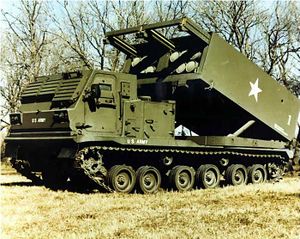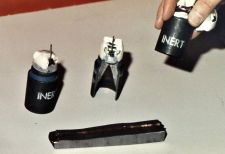M270 Multiple Launch Rocket System
| M270 Multiple Launch Rocket System (MLRS) | |
|---|---|
 M270 MLRS |
|
| Type | Rocket artillery |
| Place of origin | |
| Service history | |
| In service | Since March 31, 1983 |
| Production history | |
| Designer | Vought Corporation |
| Designed | 1977 |
| Manufacturer | Lockheed Martin, Diehl BGT Defence |
| Produced | 1980–2003 |
| Variants | M-270A1 |
| Specifications | |
| Weight | 55,000 lb |
| Length | 22 ft 6in |
| Width | 9 ft 9in |
| Height | 8.5 ft |
| Crew | 3 |
|
|
|
| Rate of fire | Rockets: 12 rounds in < 60 sec
Missiles: 2 rounds in 20 sec |
|
|
|
| Primary armament |
M269 Launcher Loader Module |
| Engine | Cummins Diesel 500 hp |
| Operational range |
300 miles |
| Speed | 40 mph |
The M270 Multiple Launch Rocket System (M270 MLRS) is a multiple rocket launcher, a type of rocket artillery.
The first rocket systems were delivered to the U.S. Army in 1983. The system is in widespread use in NATO countries and it has also been manufactured in Europe. Some 1,300 M270 systems have been manufactured, along with more than 700,000 rockets. The system has been used in the Gulf War and Iraq War, where it proved itself as a practical and effective weapons system. The production of the M270 ended in 2003, when a last batch was delivered to the Egyptian army.
Contents |
Overview
The system is capable of firing guided and unguided projectiles to a distance of up to 42 km (26.1 miles). Firing ballistic missiles, (such as the U.S. Army Tactical Missile System—ATACMS) it is capable of reaching out to 300 km (186 miles) with the warhead reaching a maximal altitude of ~50 km (164,000 ft). The M270 is a very mobile unit, thus well suited for the so called shoot-and-scoot tactic: it can fire its rockets very rapidly and immediately move away to avoid returning counter-battery fire.
MLRS was developed jointly by the United Kingdom, United States, Germany, and France. It was developed from the older General Support Rocket System (GSRS).
The rockets and ATACMS missiles are contained in interchangeable pods. Each pod contains six standard rockets or one guided ATACMS missile (the two types cannot be mixed). The launcher can hold two pods at a time, which it loads using an integrated crane. All twelve rockets or two ATACMS missiles can be fired in under a minute. One launcher firing twelve rockets can completely blanket one square kilometer with submunitions. For this reason, the MLRS is sometimes referred to as the "Grid Square Removal Service"[1] (metric maps are usually divided up into 1km grids). The U.S. Army is currently working on developing and fielding unitary (one large warhead instead of submunitions) rocket and ATACMS variants, as well as a guided rocket.
MLRS has recently been upgraded with guided rounds. Phase I testing of a guided unitary round (XM31) was completed on an accelerated schedule in March 2006. Due to an Urgent Need Statement the guided unitary round has already been fielded and used in action in Iraq.[2] Lockheed Martin also received a contract to convert existing M30 DPICM GMLRS rockets to the XM31 unitary variant.[3]
Service history

When first deployed with the U.S. Army, the MLRS was used in a composite battalion consisting of two batteries of traditional artillery (howitzers) and one battery of MLRS SPLLs (self-propelled loader/launchers). The first operational organic or "all MLRS" battalion 4th Bn, 27th FA started training in the winter of 1985 at Ft. Sill, Oklahoma. Alpha Battery, 4/27th FA (MLRS) was deployed en masse to Peden Barracks at Wertheim, West Germany in April of that year. "Sudden Impact" as it was known by its members fired its first rounds in theater and was considered operational by June of that year. Three other firing batteries soon joined. A btry 92FA (MLRS) Was deployed to the gulf war in 1989 from Ft.Hood Texas. 3/27th FA (MLRS) out of Ft. Bragg deployed in support of Operation Desert Shield in August of 1990. 6/27th FA (MLRS) deployed in support of Operation Desert Shield in October 1990, December 1990 1/27th FA (MLRS) part of the 41st BDE (Babenhausen,Germany) deployed, and 1/158th FA from Ft Sill deployed in January 1991. A Btry 6/27th FA was the first ground unit to fire in support of Operation Desert Storm, firing a missile at approximately 00:40 (12:40am) January 18. The 4/27th FA (MLRS) was deployed in support of Operation Desert Shield on Christmas Day 1990. In early Feb 91 1/27th FA launched the biggest MLRS night fire mission in history.[4] It has since been used in numerous military engagements including the 2003 invasion of Iraq. In March 2007 the British Ministry of Defence decided to send a troop of MLRS to support ongoing operations in Afghanistan's southern province of Helmand; they will use newly developed guided munitions.
MLRS rockets and missiles

The M270 system can fire MFOM, MLRS Family Of Munition rockets and artillery missiles, which are manufactured and used by a number of countries. These include:
- M26 (United States): Rocket with 644 M77 Dual-Purpose Improved Conventional Munitions (DPICM) sub-munitions, range of 32 km.
- M26A1 (United States): Extended Range Rocket (ERR), with range of 45 km and using improved M85 submunitions.
- M26A2 (United States): As M26A1, but using M77 submunitions.
- M27 (United States): Completely inert training Launch Pod/Container to allow full loading cycle training.
- M28 (United States): Training rocket. M26 with three ballast containers and three smoke marking containers in place of submunition payload.
- M28A1 (United States): Reduced Range Practice Rocket (RRPR) with blunt nose. Range reduced to 9 km.
- XM29 (United States): Rocket with Sense and Destroy Armor (SADARM) submunitions. Not standardized.
- M30 (United States): Guided MLRS (GMLRS). A precision guided rocket, range over 60 km, in pre-production, with a standard load of 404 M85 submunitions.
- M31 (United States): Guided Unitary MLRS. Variant of the M30 with a unitary high-explosive warhead for use in urban and mountainous terrain.[5]
- M39 (United States): Army Tactical Missile System (Army TACMS), with a range of 97 km with 950 antipersonnel and antimateriel (APAM) M74 grenades.
- XM135 (United States): Rocket with binary chemical warhead (VX (nerve agent)). Not standardized.
- MGM-140A (United States): Army Tactical Missile System (ATACMS). A large guided missile using the M270 launcher, with a variety of warheads.
- AT2 (Germany, UK, France): SCATMIN Rocket with 28 anti-tank mines and range of 38 km.
- PARS SAGE-227 F (Turkey): Experimental Guided MLRS (GMLRS) developed by TUBITAK-SAGE to replace the M26 rockets.
Selected rocket specifications
- Caliber: 227 mm (8.94 in)
- Length: 3.94 m (12.93 ft)
- Motor: Solid-fuel rocket
- M26
- Weight: 306 kg (675 lb)
- Maximum range: 32 km (20 mi)
- Warhead: 644 M77 DPICM submunitions
- M26A1/A2
- Weight: 296 kg (650 lb)
- Maximum range: over 45 km (28 mi)
- Warhead:
- M26A1: 518 M85 DPICM submunitions
- M26A2: 518 M77 DPICM submunitions
- M30/M31
- AT2 SCATMIN
- Weight: 561 lb (254 kg)
- Maximum range: 39 km (24 mi)
- PARS SAGE-227 F
- Weight: over 300 kg/160 kg
- Maximum range: 70 km (43 mi)
M993 Launcher specifications
- Entered service: 1982 (U.S. Army)
- First used in action: 1991 (First Gulf War)
- Crew: 3
- Weight loaded: 24,756 kg
- Length: 22 ft 6 in
- Width: 9 ft 9 in [7]
- Height (stowed): 2.57 m (8 ft 5 in)[8]
- Height (max elevation): not available
- Max road speed: 64 km/h
- Cruise range: 480 km
- Reload time: 4 min (M270) 3 min (M270A1)
- Engine: Turbo-charged V8 Cummins VTA903 diesel 500 hp ver2.
- Crossdrive turbo transmission fully electronically controlled
- Average unit cost: $2.3 million[9]
Operators
 Bahrain: Bahrain Army (9) (no longer in service)
Bahrain: Bahrain Army (9) (no longer in service) Denmark: Royal Danish Army (12) (no longer in service)
Denmark: Royal Danish Army (12) (no longer in service) Egypt: Egyptian Army (26) (no longer in service)
Egypt: Egyptian Army (26) (no longer in service) Finland: Finnish Army (22)
Finland: Finnish Army (22) France: French Army (56)(no longer in service)
France: French Army (56)(no longer in service) Germany: German Army (called MARS Mittleres Artillerie Raketen System) (50+202)
Germany: German Army (called MARS Mittleres Artillerie Raketen System) (50+202) Greece: Hellenic Army (36)
Greece: Hellenic Army (36) Israel: Israel Defense Forces (called "Menatetz" מנתץ)
Israel: Israel Defense Forces (called "Menatetz" מנתץ) Italy: Italian Army (22)
Italy: Italian Army (22) Japan: Japan Ground Self-Defense Force (90)
Japan: Japan Ground Self-Defense Force (90) Netherlands: Royal Netherlands Army (no longer in active service; sold to Finnish Army) (30)
Netherlands: Royal Netherlands Army (no longer in active service; sold to Finnish Army) (30) Norway: Norwegian Army (12) (no longer in active service)
Norway: Norwegian Army (12) (no longer in active service) South Korea: Republic of Korea Army (58+38)
South Korea: Republic of Korea Army (58+38) Turkey: Turkish Army (12)
Turkey: Turkish Army (12) United Kingdom: Royal Artillery (67)
United Kingdom: Royal Artillery (67) United States: United States Army (840+151)
United States: United States Army (840+151)
Nicknames
US military operators refer to the M270 as "the commander's personal shotgun" or as "battlefield buckshot." It is also commonly referred to as the "Gypsy Wagon", because crews store additional equipment such as camouflage netting, cots, coolers, and personal items on top of the vehicle as the launcher itself lacks adequate storage space for the crew. Within the British military a common nickname is "Grid Square Removal System." With the adoption of the new M30 GPS guided rocket it is now being referred to as the "70 kilometer sniper rifle." [10] During the 1991 Gulf War, the Iraqis referred to the small M77 submuntions rockets as the "Steel Rain."
See also
- Multiple rocket launcher
- High Mobility Artillery Rocket System
- M-numbers
References
- ↑ Ben Rooney, "Tank-busting helicopters ready for action", Daily Telegraph, April 21, 1999.
- ↑ "Guided MLRS Unitary Rocket Successfully Tested", Microwave Journal, Vol. 49, No. 3 (March 2006), page 39.
- ↑ "Lockheed Gets $16.6M to Convert MLRS Rockets, Asked to Speed Up GMLRS Production (updated)", Defense Industry Daily, August 2, 2006.
- ↑ "MLRS Gridsmashers - First Combat Fire (Historic)", YouTube video, 13 February 1991
- ↑ Guided Unitary MLRS Rocket, Lockheed Martin, retrieved: 30 March 2010
- ↑ http://www.designation-systems.net/dusrm/app4/mlrs.html
- ↑ Army Technology - MLRS Multiple Launch Rocket System - Specifications
- ↑ 227mm Multiple Launched Rocket System (MLRS)
- ↑ globalsecurity.com M270
- ↑ http://perfunction.typepad.com/perfunction/2008/01/gmlrs-the-70-ki.html
External links
- Lockheed US MLRS at Army-Technology.com
- British MLRS
- Designation Systems
- Diehl BGT—German developer and manufacturer of GMLRS (site in English)
- Danish M270 MLRS
|
||||||||||||||||||||||||||||||||||